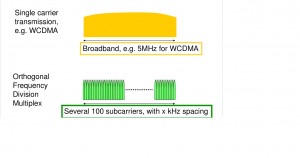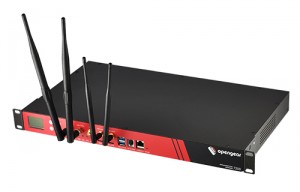As first seen on Wired.com.
LTE (Long Term Evolution of GSM/UMTS), marketed as 4G, emerged as the winner of the broadband cellular wars following the initial release of 3G (3rd Generation Partnership Project UMTS-3GPP & EV-DO-3GPP2). During the past 5 years a plethora of technologies filled the void between 3G and the promised 4G with titles such as 3.5G (HSPA, EV-DO Rev. A), 3.75G (HSPA+, EV-DO Rev. B) and 3.9G(DC-HSPA+, EV-DO Rev.C).
Although claimed as an evolution of GSM/UMTS, LTE (3GPP Rel 8 or later) is incompatible with existing 2G and 3G wireless interfaces and requires a separate spectrum. So why go with a new standard and new frequency bands that can’t slot into the existing North American 800~850/1900 MHz bands? Well LTE is completely different to GSM (TDMA) or CDMA or even WCDMA and it boasts 100Mbps (DL) and 50Mbps (UL) and multiples thereof if multiple input/output (MIMO) antennas are used up to 300Mbps (DL). How is this achieved?
LTE uses OFDM (Orthogonal Frequency Division Multiplexing) for the downlink where multiple sub-carriers each transport data at a low rate. The data to be transmitted is split across all the carriers to give resilience against selective fading from multi-path effects. LTE defines a number of channel bandwidths (1.4MHz to 20MHz) and the greater the bandwidth, the greater the channel capacity. For the LTE uplink, a different concept is used for the access technique and the implementation is called Single Carrier Frequency Division Multiple Access (SC-FDMA). These are not new theoretical techniques and have been incorporated in other wireless technologies as well as DSL and digital TV. However recent advances in electronics have made the complex mathematical tasks of paralleling data and spreading it across sub-carriers, modulating them and then recombining them possible, all embedded inside tiny radio modules.
 So we have a new standard, directly incompatible with the previous air networks and not only that, LTE is an all IP network but its very short 1mS radio frames deliver low latency of 20mS~50mS round-trip. Then you have the carriers’ influence. You would think when AT&T and Verizon both chose the 700 MHz band that may guarantee LTE interoperability of equipment. Well apparently 700 MHz is a misnomer, AT&T uses 700 MHz band 17 (Tx: 704–716 MHz Rx: 734–746 MHz) while Verizon uses 700 MHz band 13 (Tx: 777–787 MHz Rx: 746–756 MHz) and then there are bands 12 and 14. Finally, take into consideration the existing spectrum’s that carriers in other countries use and the list of LTE bands is enormous (800/900/1700/1800/1900/2100/2300/2600 MHz).
So we have a new standard, directly incompatible with the previous air networks and not only that, LTE is an all IP network but its very short 1mS radio frames deliver low latency of 20mS~50mS round-trip. Then you have the carriers’ influence. You would think when AT&T and Verizon both chose the 700 MHz band that may guarantee LTE interoperability of equipment. Well apparently 700 MHz is a misnomer, AT&T uses 700 MHz band 17 (Tx: 704–716 MHz Rx: 734–746 MHz) while Verizon uses 700 MHz band 13 (Tx: 777–787 MHz Rx: 746–756 MHz) and then there are bands 12 and 14. Finally, take into consideration the existing spectrum’s that carriers in other countries use and the list of LTE bands is enormous (800/900/1700/1800/1900/2100/2300/2600 MHz).
There is a global move to free up the 700 MHz spectrum in most countries (currently 800 MHz in EU) when old analog TV broadcast services are re-purposed and this is known as the Digital Dividend. The band actually occupies 698-806 MHz. This lower-frequency spectrum provides excellent in-building coverage and improved wide area coverage in regional and rural areas. Most countries outside the U.S, are considering eventually standardizing on the 700 MHz (APT band 28) spectrum with the inclusion of a two-duplexer system in the devices and network equipment. The goal is the utopia of any user being able to operate a mobile device in any network in the 700 MHz spectrum where the APT band plan is deployed. Many carriers in APAC are enabling APT band 28 LTE services in early 2015.
In the United States all cellular products (even with approved modules) need to satisfy regulatory (FCC), industry (PTCRB – PCS Type Certification Review Board ) and Carrier (AT&T, Verizon and Sprint) test cases for certification. Without passing these rigorous tests the carrier will not allow or activate them on their networks. Currently, even though 4G coverage is growing few products incorporate a 4G-only radio module since the risk of questionable reception is still real. Therefore the testing of 4G cellular products includes existing 2G/3G and now entirely new 4G requirements.
The PTCRB is predominantly concerned with device emissions and quality of radio transmissions defined in the North American Permanent Reference Document (NAPRD03). The test cases include – spurious frequencies emitted while idle or while transmitting (RSE), receiver sensitivity (TIS – a spherical sweep), antenna power/efficiency (TRP – a spherical sweep) and SIM card electrical tests. Most tests (based on 3GPP, ETSI and CTIA standards) are carried out for every frequency band the radio module supports for 2G/3G and 4G. All PTCRB test goals are aggressive and difficult to achieve to ensure your device does not have an adverse effect on the performance or emissions of the approved radio module alone. GSM-based carriers (AT&T) in the US mandate PTCRB certification. While PTCRB testing began at $15,000 for 2G products, it is now more like $50,000 for 4G products when using a third party lab.
 On the other hand Verizon testing focuses on how your device performs on its network. Tasks including how often it associates on the network; are network disconnections in conformance; are commands executed reliably, etc. However since CDMA and LTE are so different, Verizon has introduced an additional suite of LTE (3GPP-based) tests to deal with performance, protocol conformance (plus IPV4 & IPV6), radio resource management and nominal TIS/TRP performance. A third-party lab can charge in the order of $60,000 for a multimode CMDA/EVDO/LTE device.
On the other hand Verizon testing focuses on how your device performs on its network. Tasks including how often it associates on the network; are network disconnections in conformance; are commands executed reliably, etc. However since CDMA and LTE are so different, Verizon has introduced an additional suite of LTE (3GPP-based) tests to deal with performance, protocol conformance (plus IPV4 & IPV6), radio resource management and nominal TIS/TRP performance. A third-party lab can charge in the order of $60,000 for a multimode CMDA/EVDO/LTE device.
A critical component of Sprint certification is querying and modifying the settings of a device over the air, either from a Network Initiated (NI) or Client Initiated (CI) request. These include Hands Free Activation (HFA) of a new wireless device; Device Configuration (DC) such as MDN, IMSI, and data settings; Preferred Roaming List (PRL) updates and Firmware updates (FUMO). They also sample test TIS and TRP.
 All Opengear cellular 3G/4G enabled products have integrated modules inside the devices. They don’t rely on notoriously unreliable plug-in USB cellular dongles that have minimal longevity, poor radio reception and are easily dislodged. An integrated solution offers higher reliability, guaranteed supply and full vendor support. Opengear has worked closely with regulatory and industry bodies (PTCRB, CTIA) as well as carriers (AT&T, Verizon and Sprint) and achieved 4G/3G/2G certification of it’s wide range of cellular enabled products which selectively support LTE, HSPA, EV-DO, GPRS, 1xRTT, GSM, or CDMA. Opengear is an established leader in providing Out-of-Band (OoBM) Management of critical IT, network and power infrastructure.
All Opengear cellular 3G/4G enabled products have integrated modules inside the devices. They don’t rely on notoriously unreliable plug-in USB cellular dongles that have minimal longevity, poor radio reception and are easily dislodged. An integrated solution offers higher reliability, guaranteed supply and full vendor support. Opengear has worked closely with regulatory and industry bodies (PTCRB, CTIA) as well as carriers (AT&T, Verizon and Sprint) and achieved 4G/3G/2G certification of it’s wide range of cellular enabled products which selectively support LTE, HSPA, EV-DO, GPRS, 1xRTT, GSM, or CDMA. Opengear is an established leader in providing Out-of-Band (OoBM) Management of critical IT, network and power infrastructure.
Since up to 30% of all Opengear products ship with integrated cellular support, it is quickly becoming the standout vendor for high-density OoBM over 4G and network fail-over to 4G-LTE. Our customers consistently asked for 4G integration and our 4G-LTE enabled products (ACM5504-5-Lx-I, ACM5508-2-Lx-I and IM7208/16/32/48-2-Lx-I) are now fueling growth. The global move to lower-frequency spectrum’s with well defined bands will bolster LTE growth though improved quality and coverage. Higher density antenna arrays (MIMO 4×4) will also increase bandwidth and reception quality. Opengear continues to innovate with LTE, working with the latest standards and newest radio devices, so the temporary pain of the additional LTE certifications across multiple carriers has been well worth it.


